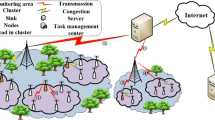Abstract
Wireless sensor networks (WSNs) are widely used in many fields of industry, agriculture, national defense, and technology. Their performance has a profound impact on their application. The storage and forwarding of WSN network packets is a typical queuing system. Based on queuing theory, this paper studies the performance analysis models of the WSN node, constructs a WSN node queuing model based on M/M/1, a WSN node queuing model with priority, a WSN node M/M/1 queuing model based on random early detection (RED) and a WSN node M/M/1 queuing model with priority based on RED. The models are analyzed theoretically and the expressions of the average delay and queue length are mathematically derived. The experimental results are consistent with the theoretical analysis. Differentiating the packets into different priorities can improve the quality of service of the network. Introducing the RED congestion control and packet discarding policy can effectively solve the congestion problem.
















Similar content being viewed by others
References
Fahmy HMA (2016) Wireless Sensor Networks: Concepts, Applications, Experimentation and Analysis. Springer Publishing Company, Incorporated
Steiner RV, Lupu E (2016) Attestation in Wireless Sensor Networks. ACM Comput Surv 49(3):1–31. https://doi.org/10.1145/2988546
Queiroz DV, Alencar MS, Gomes RD, Fonseca IE, Benavente-Peces C (2017) Survey and systematic mapping of industrial Wireless Sensor Networks. J Netw Comput Appl 97:96–125. https://doi.org/10.1016/j.jnca.2017.08.019
Bisnik N, Abouzeid AA (2009) Queuing network models for delay analysis of multihop wireless ad hoc networks. Ad Hoc Netw 7(1):79–97. https://doi.org/10.1016/j.adhoc.2007.12.001
Chen YC, Kurose J, Towsley D (2011) A mixed queueing network model of mobility in a campus wireless network. In: Infocom, IEEE. https://doi.org/10.1109/infcom.2012.6195673
Hu J, Min G, Woodward ME, Jia W (2011) Analytical Modelling of IEEE 802.11e Enhanced Distributed Channel Access Protocol in Wireless LANs. In: Performance Models and Risk Management in Communications Systems. Springer Optimization and Its Applications, pp. 173–190
Khalaf R, Rubin I (2007) Throughput and Delay Analysis in Single Hop and Multihop IEEE 802.11 Networks with Capture. 2007 IEEE International Conference on Communications, Glasgow. https://doi.org/10.1109/icc.2007.624
Bo XI (2007) Performance Improvement of Embedded Web System Based on Queuing Theory. Comput Eng 33(17):120–122. https://doi.org/10.1016/j.cageo.2006.02.011
Bansod SL, Honale S (2015) Priority based Multi-Queue Packet Scheduling Scheme for Wireless Sensor Network. International Journal of Advanced Research in Education Technology 2:3
Yin H, Qi H, Xu J, Huang X, He A (2014) An Efficient Multitask Scheduling Model for Wireless Sensor Networks. J Appl Math 2014:7. https://doi.org/10.1155/2014/969523
Shelke MP, Malhotra A, Mahalle P (2017) A packet priority intimation-based data transmission for congestion free traffic management in wireless sensor networks. Comput Electr Eng 64:248–261. https://doi.org/10.1016/j.compeleceng.2017.03.007
Jagabathula S, Shah D (2011) Fair Scheduling in Networks Through Packet Election. IEEE Trans Inf Theory 57(3):1368–1381. https://doi.org/10.1109/tit.2010.2103851
Jan MA, Nanda P, He X, Liu RP (2014) PASCCC: Priority-based application-specific congestion control clustering protocol. Comput Netw 74:92–102. https://doi.org/10.1016/j.comnet.2014.09.005
Karim L, Nasser N, Taleb T, Alqallaf A (2012) An efficient priority packet scheduling algorithm for Wireless Sensor Network. IEEE International Conference on Communications. https://doi.org/10.1109/ICC.2012.6364150
Kamarei M, Hajimohammadi M, Patooghy A, Fazeli M (2015) An Efficient Data Aggregation Method for Event-Driven WSNs: A Modeling and Evaluation Approach. Wirel Pers Commun 84(1):745–764. https://doi.org/10.1007/s11277-015-2659-9
System NT (2013) Fundamentals of Queuing Systems
Haviv M (2013) Queues–A Course in Queueing Theory
Hassin R, Haviv M ((2003)) Priorities. In: To Queue or Not to Queue: Equilibrium Behavior in Queueing Systems. pp. 73–108. Springer US, Boston
Yahya B, Ben-Othman J, Mokdad L (2011) An Energy Efficient Priority-based QoS MAC Protocol for Wireless Sensor Networks. IEEE International Conference on Communications. https://doi.org/10.1109/icc.2011.5962414
Paek KJ, Kim J, Song US, Hwang CS (2007) Priority-Based Medium Access Control Protocol for Providing QoS in Wireless Sensor Networks. IEICE - Transactions on Information and Systems E90-D(9):1448–1451. https://doi.org/10.1093/ietisy/e90-d.9.1448
Narawade V, Kolekar UD (2018) ACSRO: Adaptive cuckoo search based rate adjustment for optimized congestion avoidance and control in wireless sensor networks. Alexandria Engineering Journal 57(1):131–145. https://doi.org/10.1016/j.aej.2016.10.005
Floyd S, Fall K (1999) Promoting the use of end-to-end congestion control in the Internet. IEEE/ACM Trans Netw 7(4):458–472. https://doi.org/10.1109/90.793002
Kelly F (1997) Charging and rate control for elastic traffic. Eur Trans Telecommun 8(1):33–37. https://doi.org/10.1002/ett.4460080106
Sharma, N., Rajput, S.S., Dwivedi, A.K., Shrimali, M. (2018) P-RED: Probability Based Random Early Detection Algorithm for Queue Management in MANET. In: Advances in Computer and Computational Sciences, pp. 637–643. Springer Singapore, Singapore
Acknowledgements
This work is partly supported by the National Natural Science Foundation of China (No. 61379100 and No. 51574232)
Author information
Authors and Affiliations
Corresponding author
Additional information
This article is part of the Topical Collection: Special Issue on Fog/Edge Networking for Multimedia Applications
Guest Editors: Yong Jin, Hang Shen, Daniele D'Agostino, Nadjib Achir, and James Nightingale
Publisher’s note
Springer Nature remains neutral with regard to jurisdictional claims in published maps and institutional affiliations.
Rights and permissions
About this article
Cite this article
Xu, Y., Qi, H., Xu, T. et al. Queue models for wireless sensor networks based on random early detection. Peer-to-Peer Netw. Appl. 12, 1539–1549 (2019). https://doi.org/10.1007/s12083-019-00759-7
Received:
Accepted:
Published:
Issue Date:
DOI: https://doi.org/10.1007/s12083-019-00759-7




